|
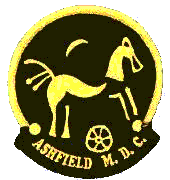
| |
Meet The Members
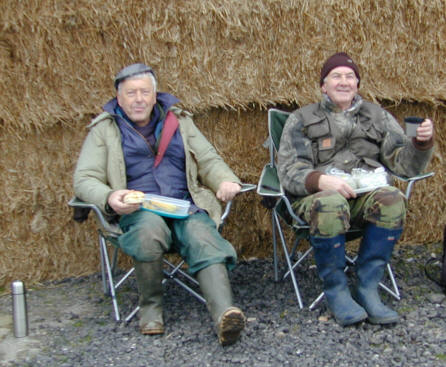 |
Roger Bacon and Eric Pursglove in a relaxed mode at lunch time |
Barry's Angel
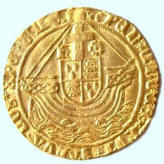
|
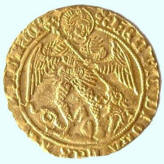
|
This beautiful gold coin was found by club member Barry Goldsmith. Unfortunately is was not
found on a club search but whilst he was on a metal detecting holiday.
The coin is a hammered gold Angel of Henry V11 1485—1509 it was worth six shillings and eight pence (33p).
The obverse showed the Archangel Michael spearing the dragon. It was introduced by Edward IV in 1465
and was not minted after 1634, the reign of Charles 1.
The Angel was bent when found but Barry has had it professionally straightened.
|
Norman's Silver Seal
 |
 |
 |
|
16mm |
32mm |
20mm |
|
Click an image for a bigger picture |
Norman Daynes is pleased to say that he has at last received his silver
seal back from the Treasure Act process. He received the seal on the
7th., of December, 2005, that is over 20 months since he found it, on
the 8th., March, 2004.
Deep In Thought
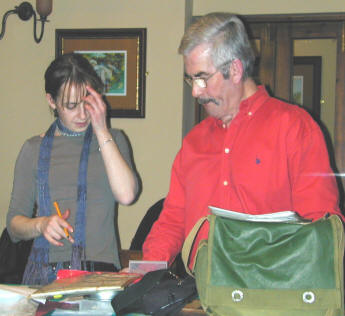
|
This photograph was taken at the February, 2006, club meeting it shows the
Finds Liaison Officer for Derbyshire and Nottinghamshire, Rachael Atherton,
studying finds made by club member John Wardle.
As well as those finds required to be ‘handed over’ in compliance with the Treasure Act,
Rachael will, at the request of the finder, forward coins or artefacts for identification
and recording to suitable experts and return them with the details at a subsequent club meeting.
John is a dedicated detectorist and together with his friend, Dennis Brown,
has hardly missed a club meeting or search since joining the club. His prowess
as a detectorist can be affirmed by the groans of, “Not him again”
that can be heard at the Find of the Month awards
|
John Radfords Recent Finds
Mystery Object
The Mystery Object in this edition of the newsletter is made of lead it was found at Bestwood,
Nottinghamshire, near to a group of recently formed fishing ponds. I have been told that it may
have been used to measure gunpowder out for flintlock firearms. That is, however, just a guess.
If anyone knows what this artefact may have been used for please contact John Gough..
|
 |
 |
Good News for Detectorists
|
Just
recently myself and other members of the club have noticed that most of the
new type shotgun cartridge cases illustration (1) found on the surface of
the ground fail to give a signal when the search head is passed over them.
Even at very low levels of discrimination they only give a scratchy, broken
signal that is easy to identify and disregard. Once the new type of shotgun
cartridges are under the soil, even to a small depth, the signals are
virtually non existent and do not present any problems. On closer
examination they appear to be made of thin ferrous metal coated with a brass
coloured varnish to imitate the solid brass of the old style cartridges. In
the illustration (2) I have scraped some of the varnish coat away to reveal
the ferrous metal underneath.
Illustration (3) shows the cause of many an exclamation from a detectorist
of, “Not Again”, when yet another good signal has turned out to be a
cartridge end. Hopefully this frustration will become rarer as the new style
case comes into general use and the old case ends decay in the soil.
Just
think about it, the demise of the detectable shotgun cartridge and the
advent of the drink can with the new type ring pull that is not detached
from the can but left with it when discarded must mean better metal
detecting. (Although the discarded drink can itself will still present a
problem).
The only
other major improvement I can think of is, if the brigade of dog in the
manger, anti metal detectorist, Dinosaurian archaeologists would become
extinct, preferably overnight. Then the newer entrants to the profession
could form their own, hopefully, unbiased opinions about the best hobby in
the world.
Good
hunting.
|
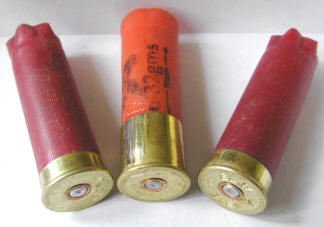 |
|
The new cartridge cases (1) |
 |
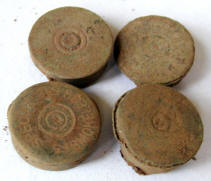 |
|
New case with ferrous metal exposed (2) |
Our old enemy.
Although they eventually decay, the centre remains to annoy
us (3) |
Display Cases
Do It Yourself Display Cases.
Most detectorists after a while accumulate many small artefacts of a similar nature,
for example buckles, buttons, badges and horse harness fitments. These are usually
kept in a box, drawer or cupboard, not seen and sometimes forgotten.
How much better for them to be easily viewed and accessible thought
club member Dennis Brown and he arrived at the simple solution of
storing them in home made display cases. Apart from the storage
problem the cases would enable displays of various themed artefacts
to be mounted almost instantly. Normally the cost of custom made
display cases would be prohibitive but Dennis designed a display case
that could be made, for next to nothing, by anyone with a rudimentary
knowledge of woodwork. If you can make simple saw cuts, use nails,
screws and glue up to Blue Peter standards you are in business.
How to make a display case.
Dennis buys, usually from a charity shop, a photograph frame with its glass
and removes the photograph and backing card this leaves the glass loose.
He fastens this in the frame recess with thin strips of wood which are
glued and nailed, the spent sticks from fireworks rockets are the ideal
thickness for this. A ⅜" x 1" lath of wood is cut into four
strips, glued and nailed with simple lap joints to make an open
frame that matches the length and width of the picture frame The two
frames are then hinged together with two small hinges or a piano hinge.
A plywood or hardboard bottom is then cut and fitted this makes up the
basic display case which can be painted or varnished to suit your
preference. To display the artefacts cut another piece of card or
hardboard to fit inside the completed case, leave it just loose
enough to accommodate the felt or other material used to cover it
and still fit snugly. To fix the artefacts to the inner covered
board will be a matter of trial and error, gluing or sewing would seem to be the easiest ways.
Cutting list.
The materials required for one of the display cases illustrated below are:-
1 x 12" x 10" photograph frame. 2 x 12" x 1" x ⅜" and 2 x 10" x 1" x ⅜" lengths of wood.
1 x 12" x 10" hardboard bottom. 1 piece of hardboard cut to fit the inside of the case and material to cover.
Long live Imperial Measurements!
Our thanks to Dennis for his idea and allowing his displays to be illustrated in this newsletter.
|
 |
 |
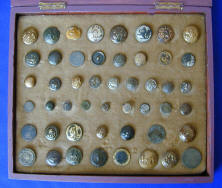 |
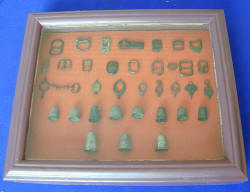 |
 |
 |
Meet The Members
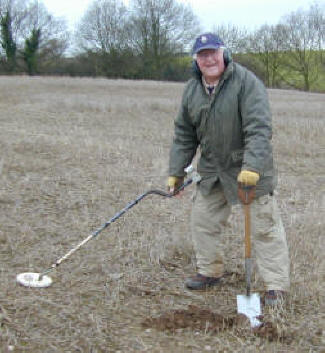 |
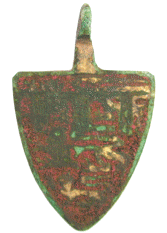 |
 |
Dave Budding
|
Horse harness pendant |
Arms of the House of Lancaster |
|
Dave Budding is an honorary member of the club now living Tucson, Arizona.
He was visiting his relatives in Nottingham, over Christmas when he had a
slight stroke which meant delaying his return until February. He was able to
attend most of the club searches during his enforced stay.
|
The horse harness heraldic pendant was found by Dave Budding on a club search.
It is thought to date between 1260 and 1340. In heraldic terms the face bore the
arms ‘gules, three lions passant guardant in pale or, a label azure semy of
fleurs-de-lis or’. Described as England with a label of France.
Dave normally uses a Minlab detector but with the uncertainties of air
travel security he decided to leave that in the USA and is using a borrowed Tesoro.
|
Nottingham Penny
 |
Nottingham City Council have paid £860 for an extremely rare William the Conqueror penny.
The small 1.5cm. diameter silver coin has on the obverse William 1 holding two
sceptres, to the left a sceptre patté and to the right a sceptre botonné,
the inscription, partly missing, should read WILLIAM REX ANGLOR.
|
The reverse has the inscription M... on SNOTTING., a cross fleury with an
annulet in centre over saltire botonné. The M is believed to be the abbreviated
name of the moneyer Manna the person responsible for minting the coin and
Snotting is an old name for Nottingham. The old Nottingham mint is thought to
have been on Bridlesmith Gate and was only in production for a short time,
the coins it issued are some of the rarest in existence, particularly the
ones with the two sceptres which were minted from 1072 to 1074.
The purchase of the coin was made by the Nottingham City Council from the
Numismatic Society of Nottinghamshire who had been given the coin by a
long standing member, Ernest Danson who in turn had been given it by the
founder of the society, Harry Pegg. Grenville Chamberlain, the Honorary
Secretary of the society said, “ Ernest felt he could not make a profit from the
gift so he gave it to the society and any profit would go to the funds.
It is probable that the proceeds will be used to finance a yearly numismatic
lecture to the society. I am delighted that the coin will stay in
Nottingham and be on display in the castle.”
Sadly this was not a metal detecting find, but now we know what we are looking
for, surely around a mint town there should be more examples to be
found even though the life of the mint was relatively short.
*****
The Numismatic Society of Nottinghamshire meet on the second Tuesday
of each month from September to April at the Cecil Roberts Room,
Central Library, Angel Row, Nottingham at 6.45pm.
|
Written by John Gough
|
